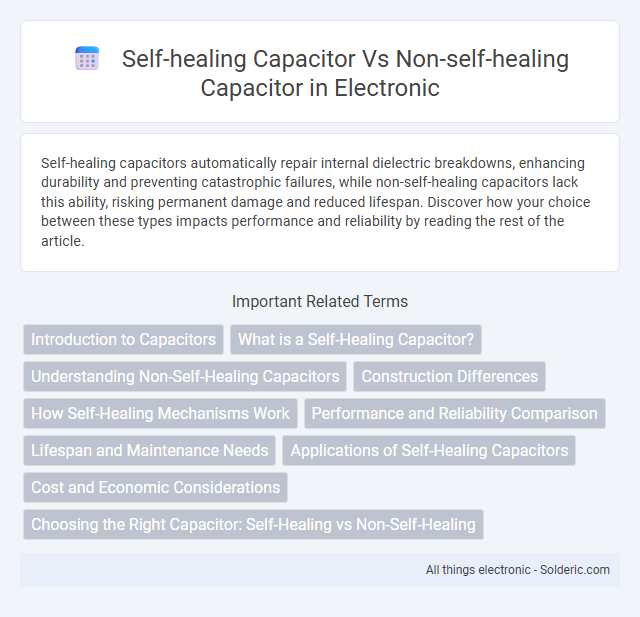Self-healing capacitors automatically repair internal dielectric breakdowns, enhancing durability and preventing catastrophic failures, while non-self-healing capacitors lack this ability, risking permanent damage and reduced lifespan. Discover how your choice between these types impacts performance and reliability by reading the rest of the article.
Comparison Table
| Feature | Self-Healing Capacitor | Non-Self-Healing Capacitor |
|---|---|---|
| Definition | Capacitor that repairs dielectric breakdowns automatically | Capacitor without automatic dielectric repair capability |
| Dielectric Breakdown Handling | Automatically isolates and repairs faults | Fault causes permanent damage or failure |
| Longevity | Longer operational life due to self-repair | Shorter life; susceptible to catastrophic failure |
| Reliability | High reliability in voltage and fault conditions | Lower reliability; risk of short circuits |
| Applications | Power supplies, high-voltage systems, electronics | Low voltage, non-critical circuits |
| Cost | Generally higher due to advanced design | Lower cost, simpler construction |
Introduction to Capacitors
Capacitors store and release electrical energy in circuits, playing a critical role in filtering, buffering, and energy storage. Self-healing capacitors feature a dielectric material that can repair minor internal damage caused by voltage spikes, enhancing reliability and lifespan. Non-self-healing capacitors lack this property, making them more susceptible to permanent failure under electrical stress, which can impact Your circuit's durability.
What is a Self-Healing Capacitor?
A self-healing capacitor is designed with a dielectric layer that can automatically repair small electrical breakdowns, restoring its insulating properties and preventing catastrophic failure. Unlike non-self-healing capacitors, which may suffer permanent damage from such faults, self-healing capacitors enhance reliability and extend lifespan in electronic circuits. You benefit from improved durability and consistent performance in applications requiring high voltage endurance and stability.
Understanding Non-Self-Healing Capacitors
Non-self-healing capacitors lack the ability to automatically recover from dielectric breakdowns, leading to permanent damage and reduced lifespan. These capacitors rely solely on their initial insulation properties, making them more susceptible to failure under electrical stress. Your choice of a non-self-healing capacitor may require more frequent maintenance or replacement in high-stress applications.
Construction Differences
Self-healing capacitors feature a unique construction with thin dielectric layers that can automatically repair punctures caused by electrical faults, enhancing reliability and lifespan. Non-self-healing capacitors lack this dielectric recovery mechanism and rely on solid insulation that, once damaged, results in permanent failure or short circuits. The inclusion of metallized film electrodes in self-healing capacitors distinguishes them from the foil electrodes used in non-self-healing types, contributing to improved fault tolerance and operational stability.
How Self-Healing Mechanisms Work
Self-healing capacitors contain thin dielectric layers designed to isolate and repair any electrical breakdowns by vaporizing the metal around the fault, preventing permanent damage and maintaining capacitor functionality. When a fault occurs, the localized heating caused by the short circuit evaporates the electrode material near the defect, restoring the dielectric and allowing the capacitor to continue operating without failure. In contrast, non-self-healing capacitors lack this mechanism, so a dielectric breakdown results in a permanent short circuit, leading to capacitor failure.
Performance and Reliability Comparison
Self-healing capacitors demonstrate superior performance and reliability by automatically isolating and repairing dielectric breakdowns, ensuring continuous operation and longer lifespan compared to non-self-healing capacitors which are prone to permanent failure after dielectric damage. The self-healing mechanism significantly reduces maintenance costs and improves system uptime in high-stress environments such as power electronics and motor drives. Non-self-healing capacitors lack this protective feature, resulting in lower fault tolerance and increased risk of catastrophic failure under voltage surges or transient conditions.
Lifespan and Maintenance Needs
Self-healing capacitors exhibit longer lifespan due to their ability to automatically repair dielectric faults, minimizing the risk of permanent damage and reducing maintenance frequency. Non-self-healing capacitors lack this capability, making them prone to early failure and necessitating more frequent inspections and replacements. The enhanced durability of self-healing capacitors leads to improved reliability in applications with high voltage stress or fluctuating conditions.
Applications of Self-Healing Capacitors
Self-healing capacitors are widely used in power electronics, renewable energy systems, and electric vehicles due to their ability to maintain performance after dielectric breakdowns. Their self-repairing property enhances reliability and longevity in high-voltage applications such as motor drives, power supplies, and pulse power systems. Compared to non-self-healing capacitors, these capacitors reduce maintenance costs and improve system safety in critical industrial and automotive environments.
Cost and Economic Considerations
Self-healing capacitors typically have higher initial costs due to advanced materials and design features that enable automatic fault repair, extending their operational life and reducing maintenance expenses. Non-self-healing capacitors are cheaper upfront but often incur higher long-term costs because they may fail catastrophically, requiring more frequent replacements and increasing downtime. Evaluating total cost of ownership, including reliability and maintenance, is crucial when choosing between self-healing and non-self-healing capacitors for economic efficiency.
Choosing the Right Capacitor: Self-Healing vs Non-Self-Healing
Self-healing capacitors feature a dielectric layer that automatically repairs minor electrical faults, enhancing reliability and extending lifespan in high-voltage applications. Non-self-healing capacitors lack this capability, leading to permanent failure upon dielectric breakdown, which necessitates careful application in circuits susceptible to voltage spikes. Selecting between these types depends on operational voltage, environmental stress, and maintenance accessibility, with self-healing capacitors preferred for critical, high-stress environments demanding long-term stability.
self-healing capacitor vs non-self-healing capacitor Infographic

 solderic.com
solderic.com